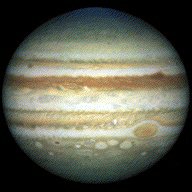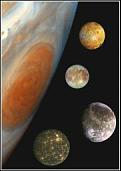
 |
Jupiter - giant failed star |
|
| |
 Vital StatsAmazing Collision in Space! In 1994, comet Shoemaker-Levy 9 crashed into Jupiter! This was the first time such an event had been witnessed in the solar system, and struck home how chillingly vulnerable we are here on earth. In 1994, comet Shoemaker-Levy 9 crashed into Jupiter! This was the first time such an event had been witnessed in the solar system, and struck home how chillingly vulnerable we are here on earth.
Read about all this, and more, in Jupiter Odyssey - the Story of NASA's Galileo Mission (UK | US). Once in a New Moon!In 2001, 10 further moons were found. In 2002, astronomers discovered 11 more. In 2003, the number of known moons rose yet again to 61! Many are remarkably tiny, some as small as one or two kilometres. The new moons tend to have retrograde orbits which may indicate that they were captured by Jupiter's gravity, rather than forming at the same time as their parent.Jupiter has a faint ring system, not visible from Earth. It was first discovered when the Voyager probes flew by, photographing it in the shadow behind the planet. Giant Among Giants Jupiter is referred to as a "gas giant", 11 times wider than Earth. It is nearly all atmosphere, with only a relatively small solid core. The atmosphere is composed mainly of hydrogen and helium, with the upper clouds formed from droplets of ammonia. The vivid visible surface shows distinct weather systems. The Great Red Spot (left), is a gigantic whirling storm, bigger than the Earth, rotating every 12 days. Also visible are bands, representing different currents occurring in the cool Jovian atmosphere. These rotate with Jupiter, the polar regions moving more slowly than the equatorial regions. Jupiter is referred to as a "gas giant", 11 times wider than Earth. It is nearly all atmosphere, with only a relatively small solid core. The atmosphere is composed mainly of hydrogen and helium, with the upper clouds formed from droplets of ammonia. The vivid visible surface shows distinct weather systems. The Great Red Spot (left), is a gigantic whirling storm, bigger than the Earth, rotating every 12 days. Also visible are bands, representing different currents occurring in the cool Jovian atmosphere. These rotate with Jupiter, the polar regions moving more slowly than the equatorial regions.
Under PressureThe planet's size creates enormous pressure at its core, producing large amounts of radiation and heat. The core may be as hot as 30,000°C! Radiation belts extend far beyond the planet into space, providing a lethal environment for spacefaring craft venturing too close. The planet also produces a powerful magnetic field. Had the planet been somewhat more massive than it is, it would be a star. There would have been enough pressure, due to gravity, to start nuclear fusion in its core. It would shine with its own light, giving the solar system two stars (a commonly observed occurrence in other parts of the Galaxy). Had this happened, life could not have existed on Earth. |
Comet CollisionOn the 18th July, 1994, Jupiter was hit by 19 fragments of
comet Shoemaker-Levy that it had pulled apart the year before. Despite striking the far side of the planet, as seen from Earth, the impacts caused explosion after explosion - and it was to be recorded by every telescope on Earth, the H.S.T. in orbit, and the Galileo probe, still 18 months away from Jupiter.
What a Sight!Close up details of Jupiter and its moons have been received by various probes launched since 1972. The first to arrive was Pioneer 10 in 1973, followed by Pioneer 11 and Voyagers 1 and 2 in 1979.
In December 1995, NASA's Galileo probe arrived, for a 3 year tour of the Jovian system, launching its own probe into the turbulent atmosphere. Much like Star Trek, the mission far outlasted its original design, surviving radiation exposure more than twice the level it was designed to withstand. In December 2000, the Cassini probe (on its way to Saturn) flew past uniquely allowing joint observations. Galileo's mission finally ended on the 21st September 2003 when it plunged into Jupiter's atmosphere. NASA had planned this to prevent the probe contaminating Europa, which may just have life beneath its icy surface. | |||||||
|
Sun | Mercury | Venus | Earth | Moon | Mars | Asteroids | Jupiter | Saturn | Uranus | Neptune | Pluto | X | Kuiper | ||||||||